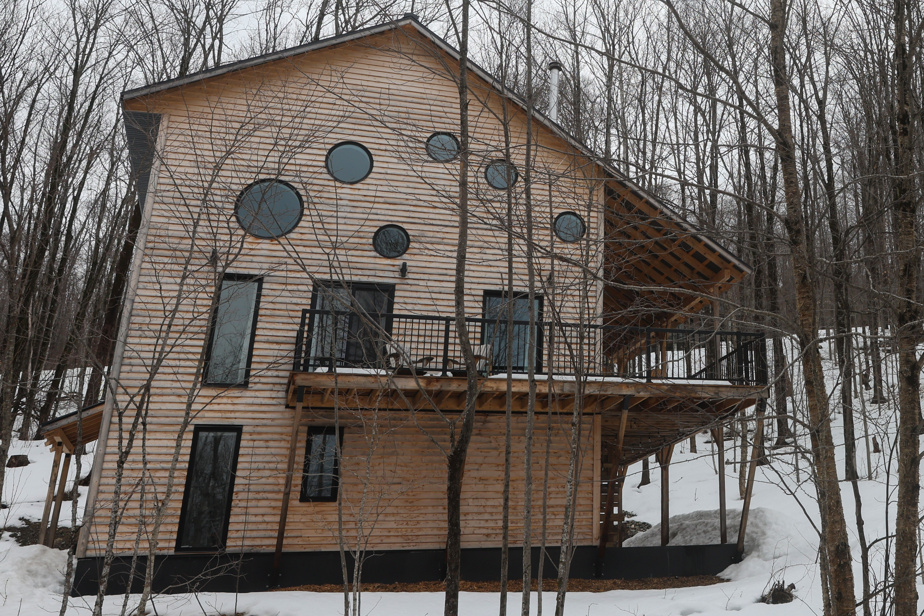Sharon Ogilvie and Stéphane Beauchamp were thinking of their old age when they bought a second piece of land in Bolton-Est in 2017. Both in the construction industry, they took advantage of their respective strengths to create a country house in their image, which will generate some rental income. Aiming for LEED Gold certification was one of the challenges they set themselves.
Together since their studies in architectural technology at Cégep du Vieux Montreal 30 years ago, they took various paths through university: she chose environmental design, while he chose engineering. construction. Having founded their company Habitat-Fix some fifteen years ago, they were ready to embark on a project which they led from A to Z, taking charge of the design and management of the site, carrying out part of the work and almost all of the finishing work, including making the concrete kitchen counters themselves.
“Preparation is key for any project, big or small,” Sharon Ogilvie reminds us. If things aren’t aligned, if we don’t have a plan, we won’t know what to do when something unexpected happens. And it always happens. »
They began drawing up the plans for their country house in 2017, thinking about it day and night and making multiple modifications, until construction began in 2021, in the midst of a pandemic. In the meantime, they have taken courses offered by Écohabitation, in order to aim for LEED Gold certification (just awarded).
“We wanted to have fun, Sharon and I, by building an ecological house,” says Stéphane Beauchamp.
“There was a visit before the installation of the gypsum to check the mechanical components and do a blower door test,” he adds. And there was a post-construction visit to ensure that everything had been respected. Insulation, sealing, glazing, all this means that we have a quality construction, which is not energy-intensive. The electricity consumption is around $100 per month, not including the electric car. »
Complying with the requirements of the LEED system has not always been easy, recognizes Sharon Ogilvie. For example, they were desperate to find a WaterSense-certified low-consumption toilet with a clean design and easy maintenance that fit their budget. “Fortunately, during the process, Produits Neptune went for certification,” she says. The toilets are also manufactured here, in Saint-Hyacinthe. »
They followed orders very closely. But it was worth it. “We didn’t miss a minute because of a lack of materials,” says Stéphane Beauchamp. We had everything in time and before. Écohabitation had suggested having a construction site container, 20 feet long, to store everything. The door was locked with a big padlock and that was very helpful. We had the windows and the IKEA furniture in there for a month, we had the hardwood floors for a few months. You have no idea of everything we bought at Costco along the way, because in addition to building it, we had to equip it, that chalet. We took what we needed as we went. »
It was important to them to use everything that came from the trees that were felled. “Nothing came out of the yard,” reveals Stéphane Beauchamp proudly. Two sawyers came to cut 1″ and 2″ boards. We used it to make the steps of our stairs, furniture, part of the gallery, lighting. It was very important for us to use wood to remind us of the existence of the wooded land. »
They are fully committed, settling in their trailer near the construction site from Friday evening to Tuesday evening to work there. They salute the competence and open-mindedness of the entrepreneur Christian Ledoux, who found solutions with them when problems arose.
“Despite all the surprises we had and the COVID extras, we have a cost overrun of 10% compared to the initial budget for 2018, notes with satisfaction Sharon Ogilvie. It took a lot of research, negotiation and economic gymnastics on the part of the entrepreneur. »
They remember with laughter the insulating wool they installed in the walls to respect their budget. They learned a lot from this first experience. They are already thinking about the next house, which they intend to build not far away.
Cost (including land): $500,000
Uncounted hours spent on the project: invaluable
Start of design: 2017
Duration of works: 15 months (from May 2021 to the end of August 2022)
Essentials: oiled hardwood floors, wood paneling on one wall and the cathedral ceiling (inside), exterior cladding in local spruce, large covered gallery to admire nature sheltered from the rain, toilets with skirt (with clean design), smart home
Another must: use wood from trees felled in the field on site















